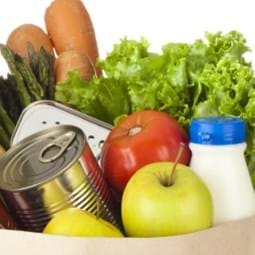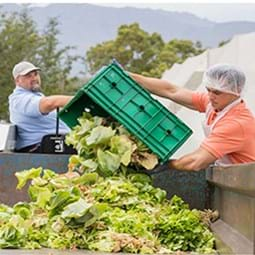
Food, Nutrition, and Food Safety
(Selected research findings from Fiscal Year 2020. Much of this research pre-dates the pandemic. Please visit www.ers.usda.gov/covid-19/ for the latest ERS research related to COVID-19)
The remaining households (10.5 percent) were food insecure at least some time during the year, including 4.1 percent with very low food security because the household lacked money and other resources for food, resulting in reduced food intake and disruptions in eating patterns for one or more household members. The 2019 prevalence of food insecurity declined to below the pre-recession (2007) level of 11.1 percent. The decline in rate of very low food security from 4.3 percent in 2018 to 4.1 percent in 2019 was not statistically significant. Children and adults were food insecure in 6.5 percent of U.S. households with children in 2019, versus 7.1 percent in 2018. The ERS food security statistics are widely recognized as the benchmark for measuring food security in the U.S., and support decision making on USDA food and nutrition assistance programs.
These food and nutrition programs represent a significant federal investment and account for roughly two-thirds of USDA’s annual budget. Spending in FY 2019 ($92.4 billion) was about 5 percent less than in the previous fiscal year and 22 percent lower than the inflation-adjusted historical high of $117.9 billion in FY 2013. Supplemental Nutrition Assistance Program (SNAP) accounted for 65 percent of all Federal food and nutrition assistance spending in FY 2019. On average, 35.7 million people per month participated in the program, 12 percent fewer than in FY 2018. On average, 6.4 million people per month participated in the Special Supplemental Nutrition Program for Women, Infants, and Children (WIC) in FY 2019, 7 percent fewer than in FY 2018. Each school day, an average 29.4 million children participated in the National School Lunch Program in FY 2019, and 14.7 million children participated in the School Breakfast Program.
Researchers and policymakers have used retail and household scanner data for almost 2 decades to estimate food prices. However, many foods in the What We Eat in America (WWEIA), which is the dietary component of NHANES, are measured as edible portions—with bones, peels, etc. removed—and many foods contain multiple ingredients, making it difficult to estimate prices of foods consumed in WWEIA from retail scanner data for foods as purchased. An ERS report presented an approach to using scanner data to estimate food prices for WWEIA/NHANES. This also supported a 2018 Farm Bill mandate to update the market basket of the Thrifty Food Plan every 5 years.
Examining the time-use patterns of the U.S. population can improve our understanding of Americans’ nutrition and health because food-related time use can influence diet and nutrition and, thereby, health outcomes. An ERS report analyzed the time Americans spent on food-related activities, as well as other time demands, which can provide insight into why nutrition and health outcomes vary over time and across regions. Americans spent 64 minutes eating and drinking as a primary activity in 2014–2017, down 4.5 percent from 67 minutes in 2004–2007. In 2014–2017 Americans spent 27.5 minutes on food preparation, an increase of 17.5 percent from 2004–2007.
During 2003-2016 veterans attained lower total scores for overall diet quality than did nonveterans.
Veterans represent about 7 to 8 percent of the U.S. adult population and may participate in Government programs, including healthcare and nutrition education programs administered by the U.S. Department of Veterans Affairs. Registered dietitians and other nutrition professionals have worked with veterans and their families (at VA healthcare facilities across the country) to promote wellness and prevent disease. An ERS study assessed veterans’ diets using data from NHANES dietary intake module. During 2003–2016, veterans’ consumption of added sugars and solid fats was too high and their consumption of fruits, vegetables, whole grains, and dairy products too low relative to the Dietary Guidelines for Americans.
USDA estimates the value of uneaten food at the retail and consumer levels at around $161.6 billion annually. Although a considerable number of studies have examined this type of food loss, few have analyzed the economic factors that result in loss of food on farms and in distribution channels. ERS researchers explored economic drivers of fresh-produce (i.e. fruits and vegetables) loss at the farm and pre-retail sectors. Price volatility, labor costs and availability, supply chain constraints, retail and consumer quality standards, contract incentives, and the policy environment are identified as factors influencing food loss on farms and in distribution channels.


 The Purchase to Plate Price Tool (PPPT) provides a method for estimating prices for foods in the National Health and Nutrition Examination Survey (NHANES).
The Purchase to Plate Price Tool (PPPT) provides a method for estimating prices for foods in the National Health and Nutrition Examination Survey (NHANES). Patterns in food-related time use during 2014 to 2017 and among demographic subgroups reveal significant changes from the 2004 to 2007 time period.
Patterns in food-related time use during 2014 to 2017 and among demographic subgroups reveal significant changes from the 2004 to 2007 time period. The balancing of expected costs, revenues and risks from the sale of fresh produce by growers and distributors plays a substantial role in pre-retail level of food loss.
The balancing of expected costs, revenues and risks from the sale of fresh produce by growers and distributors plays a substantial role in pre-retail level of food loss.